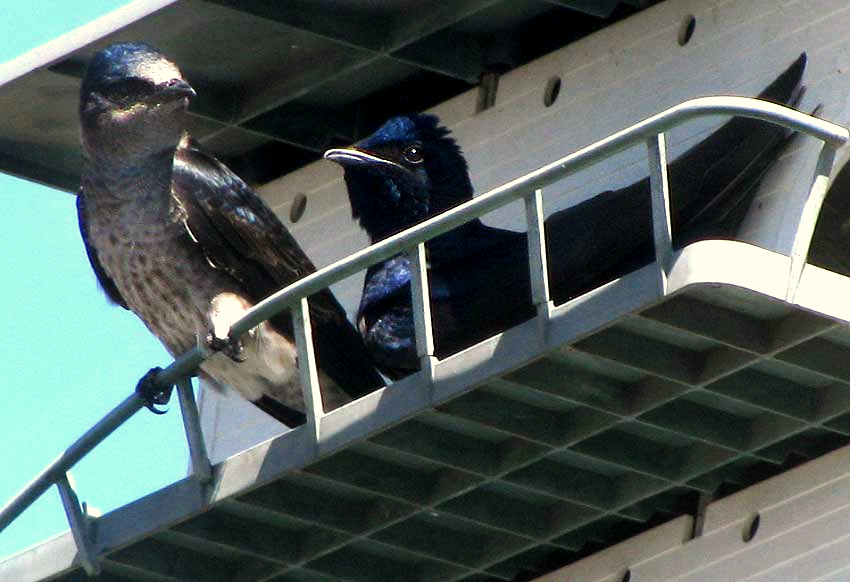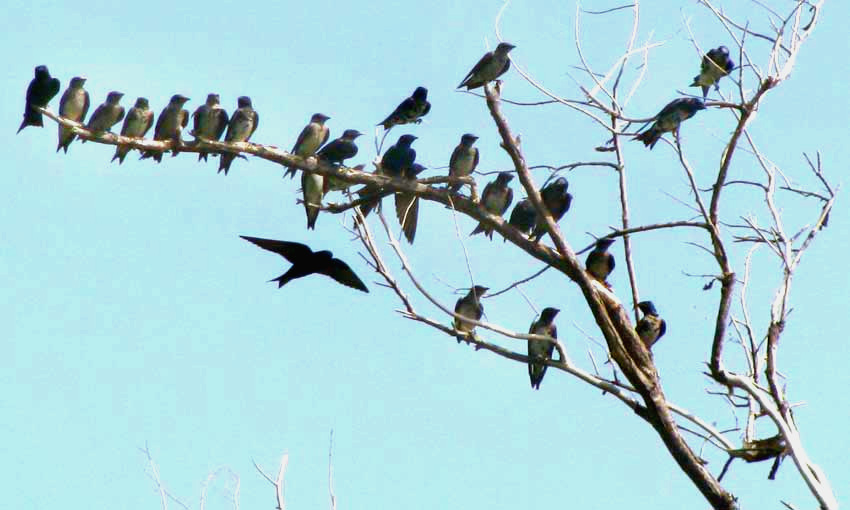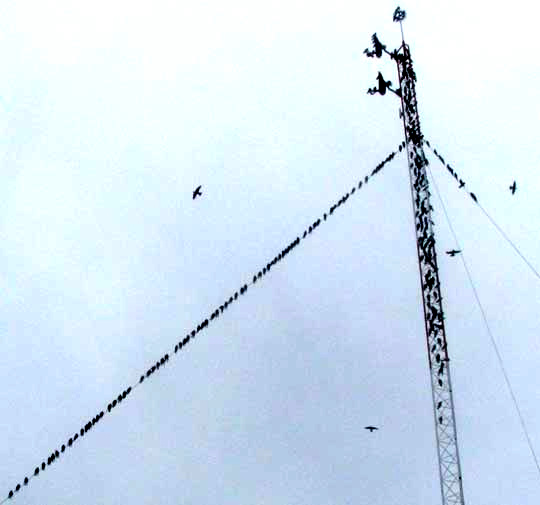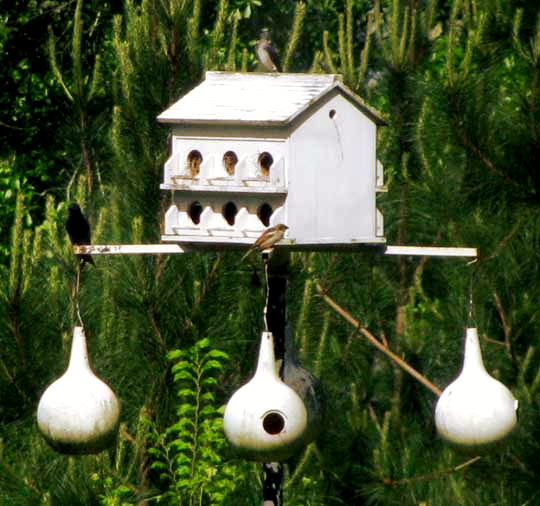Excerpts from Jim Conrad's
Naturalist Newsletter

from the March 17, 2013 Newsletter issued from the valley of the Dry Frio River in northern Uvalde County, southwestern Texas, on the southern border of the Edwards Plateau; elevation ~1750m (~5750 ft); N29.62°, W99.86°; USA
MARTINS HAVE LANDED
Last Sunday, March 10th, a certain familiar, bubbly chortle cascaded from the sky, and sure enough it was a pair of Purple Martins freshly arrived from Brazil or thereabouts for their summer of nesting. Above you can see the pair on the bird box just a few feet from where I was sitting.
The female with her gray underparts perches at the left while the blackish blue male attends at the right. Normally male "scouts" who search for nesting sites arrive a few days before the females, so probably the male was here earlier. You can see the status of arrival of male scouts across North America, and report your own scouts' arrivals, on the Purple Martin.org Scout Report Page at https://www.purplemartin.org/research/8/scout-arrival-study/.
It's the female who decides where to nest, and which male she wants to pair with for the season. She often returns to where she nested previously. Upon her arrival, her first job is to review the available males competing for her and other females. Once a pair is bonded, both sexes share in nest building and maintenance, in defending the nest, and both feed and care for the offspring. Purple Martins often nest in colonies, but members of the breeding colony are not related.
Martins are monogamous, but both sexes are highly promiscuous. Females may have multiple mates while maintaining a single nest. Studies show that the less impressive the male is in a bonded pair, the more likely the female is to mate with other more dynamic males during the mating season. From an evolutionary perspective this is an elegant strategy because it provides more dynamic birds more chances to pass along their genes, while not wasting the willingness of less desirable males to defend a nest and care for nestlings.
Our visiting martin couple here along the Dry Frio didn't stay long and didn't return on subsequent days, so probably the female didn't like the nest and/or the male she was with. One problem with the nest may have been that House Sparrows already had occupied several compartments in the bird box. You can read about House Sparrows and Starlings being "super competitors" for Purple Martins at https://www.purplemartin.org/forum/viewtopic.php?t=4987.

from the the July 31, 2011 Newsletter issued from written at Mayan Beach Garden Inn 20 kms north of Mahahual, Quintana Roo, México
MARTINS ON THE MOVE
I'd gone looking for the recently fledged Common Black Hawk we've been watching but he wasn't to be found. However, not far from the old nest, thirty or so twittering, antsy swallows, I thought, were perched on a snag. You can see what they looked like above.
If we'd been up at Hacienda Chichen I'd have called them Ridgway's Rough-winged Swallows and not given a second look. However, so far this summer I've not seen a single swallow here, so I wondered whether they might be something special. Also, these birds somehow -- even with all their twittering and fidgeting -- didn't seem quite as hyperactive and nervous as the Hacienda's Ridgway's. Once I got the picture onto my laptop screen I saw why: They weren't Ridgway's. They weren't even swallows.
First of all, even with their dusky chests and throats, they're not Ridgway's Rough-wingeds because their tails are too deeply notched. Then I thought of Gray-breasted Martins, which are fairly common throughout lowland Mexico, but then I began noticing that some of the birds appeared to be completely black with a bluish cast, not just silhouetted so as to look black. In the picture, the bird at the branch's tip looks completely black while the one next to it, in the same light, has a pale breast. These are Purple Martins!
But, these days, aren't Purple Martins supposed to be summering up north? Since they nest far to the north of here, and winter in South America, they appear in the Yucatán only during spring and fall migration.
In A Guide to the Birds of Mexico and Northern Central America, Howell's fine-print on Purple Martin distribution says that the species is common to fairly common on Mexico's Atlantic Slope (here) during the spring migration from late January to May, and during the fall migration from July to October...
So, that's it! Here on the Yucatán's Caribbean coast already in July (July 24th, to be exact) these Purple Martins -- mostly immatures in the picture -- are inaugurating the fall migration season. The birds in the picture are freshly arrived from North America and are headed south to South America, mainly Brazil.
Yesterday, Saturday morning, for about half an hour a diffuse cloud of Purple Martins flew along the beach low enough for the naked eye to easily make out their forked tails, and every one of them was headed south. At any one time five or ten birds might be view, so maybe in all a couple hundred passed. After that half hour passage, for another half hour a few lone stragglers followed.
So, how about that? In a flash, in this land of eternal summer, my personal general perception of the current season has flipped from its being "late spring" to "early fall," without having ever noticed a "summer" at all.
from the August 7, 2011 Newsletter issued from written at Mayan Beach Garden Inn 20 kms north of Mahahual, Quintana Roo, México
PURPLE MARTINS GALORE
Last week we were impressed by twenty Purple Martins resting on a snag as they migrated from North America back to South America for the winter. Now look below:

That's Mayan Beach Garden's antenna tower at midday last Tuesday. For the rest of the week no such gathering took place, though the next day at the same hour five lonely birds perched at the very top. In the picture, of the ones on the diagonal wire, only about one in fifteen were black-breasted adult males.
from the February 24, 2002 Newsletter, issued from near Natchez, Mississippi, USA:
PURPLE MARTIN SCOUTS
All week I've been hearing scouting Purple Martins flying so high that I was never able to see one. The species has overwintered in Brazil and thereabouts in South America and now the first males are coming north, apparently scouting out the best nesting locations in preparation for the ladies' arrivals.
If you are interested in Purple Martins you should visit The Purple Martin Conservation Association's website at https://www.purplemartin.org/. There you'll see that my "first spotting" this week isn't an especially early one for here. By clicking on Mississippi in the clickable world map I found that on January 22 of this year Jess & Wes Engels in Bolivar County up in the Delta spotted the state's first. On that Web page another map shows that the first scouts average arriving at my home area in Kentucky around March 10, Chicago around April 1, and Edmonton, Alberta, Canada around May 1.
from the April 8, 2012 Newsletter, issued from near Natchez, Mississippi, USA:
MARTIN BOX
Right below my old hermit trailer at the edge of the woods a neighbor has dammed up a little pond and right next to it erected a very nice "martin box" -- a birdbox designed especially for Purple Martins. Some old-time gourds even dangle below the box offering alternative living space. Purple Martins have found the box, gourds and pond to their liking so, each day, all day long, in the background I can always hear them chortling and calling You can the whole setup below:

In that picture an all-blue-black male perches at the left, a female with a gray chest and throat sits atop the box, and a male House Sparrow stations himself right in the middle, because House Sparrows like martin boxes, too. House Sparrows typically are town or farm dwellers. We're so far from town and farms that this is the first time I've seen a House Sparrow at this area, so the neighbor's martin box must have been a strong attraction to the sparrow.
In fact, over a million North Americans put up martin boxes and many wage wars with House Sparrows and starlings, which are invasive species from Europe, and which very successfully push aside our native Purple Martins. At https://www.purplemartin.org/purple-martins/competitors/58/native/, the Purple Martin Conservation Association has this to say about the matter:
When House Sparrows or European Starlings lay first claim to martin housing at unestablished sites, they fill the compartments with their nests, then chase off investigating martins. At established colony sites, House Sparrows and starlings will fight with nesting martins, kill their nestlings, and/or break eggs. Allowing House Sparrows and starlings to nest in martin housing will significantly reduce martin occupancy and productivity.
from the March 3, 2002 Newsletter, issued from near Natchez, Mississippi, USA:
PURPLE MARTINS & HUMMINGBIRDS
Last week I mentioned hearing Purple Martin scouts migrating northward. At our Nat-Nat Chat, Margarite in Minnesota mentioned that martin populations in her area seem to have diminished. She wondered "if they are considered one of the neotropical songbirds that are in decline.
From what I can gather, the answer is yes. At the PurpleMartin.Org main page regular updates and videos are provided addressing the situation, which appears to be desperate.
Before long Ruby-throated Hummingbirds should arrive here. Generally they come in mid March. If you are a hummingbird fanatic you should know about Operation RubyThroat at http://www.rubythroat.org. At that site there are pages on "attracting hummers" and for "posting your data."
from the July 27, 2006 Newsletter, issued from Polly's Bend, Garrard County, in Kentucky's Bluegrass Region, USA:
PURPLE MARTINS IN THE BLACKLOCUST
Next to the old farmhouse there's a fair-sized Blacklocust tree with a dead top. Its upper third is a splintered, asymmetrical, zigzagging confusion, very much in aesthetic conflict with the surrounding rolling green hilltops and wooded valleys.
The nice thing is that this monstrosity makes a fine perch each day for 15-25 Purple Martins, mostly young ones with pale breasts. On hot, sunny, muggy afternoons they lounge up there stretching and preening as their parents fly around catching food and carrying it to them. I haven't seen any martin boxes around here and I think they must come from several miles away where some boxes stand next to a pond.
When they first got here the young would stay on their perch and quiver their wings as the adult approached, often with a large dragonfly clearly visible in its beak. Nowadays the young are showing more enthusiasm, often flying to meet the adults when they see them coming. When this happens the adult is likely to lead the kid on a little chase, obliging them to try those wings and learn some aerial acrobatics. Other times the parent flies past the approaching young and carries food to the shyer one staying on the limb but probably just as hungry.
When the adults fly away for food, often they go so far that I lose their images in my binoculars, so these foraging trips are not mere strolls around the tree, but major expeditions. Everyone talks about Purple Martins eating mosquitoes, and I suppose they do, but from what I see they really prefer bigger prey, especially dragonflies, butterflies and moths.
Often an adult returns from a trip with no food. They land on the perch, one or more young hop near begging, and the adult opens its mouth and issues a rough aaaaaaah! call, easy enough to interpret as "Let me alone!"
I'll bet that within a week the young will be spending most of their time soaring for their own food. Their numbers are dwindling each day even now.
In fact, sometimes flocks of 15 or so martins arrive above the hayfield, all circling the way martins do, but the flocks have two special features. One, nearly all of them are immatures. Two, there is one adult among them calling very loudly, harshly, so that one thinks of a sergeant barking commands at raw recruits, though maybe it's only an adult keeping the flock together by presenting a sound all the young ones can cluster around.
I hope no one cuts the top of that Blacklocust tree. For the whole next year it'll rise dark and disconcerting above the tree but this time next year, once again, it'll be just the perfect place for another generation of hungry, pretty martins. I wish everyone saw such limbs not as eyesores but as monuments to hope for another season of stretching and preening.
There's a lot of information about Purple Martins at http://www.purplemartin.org.